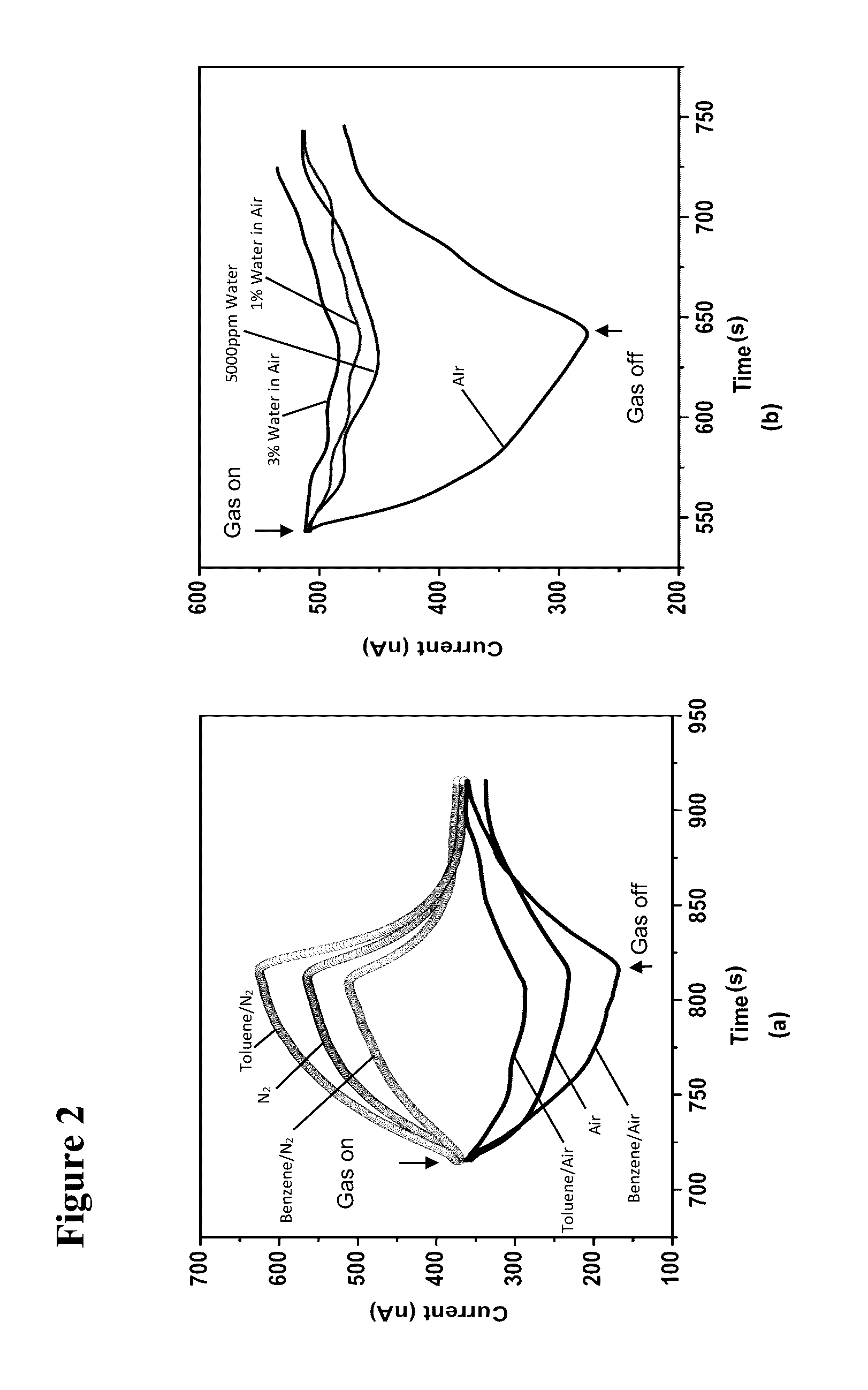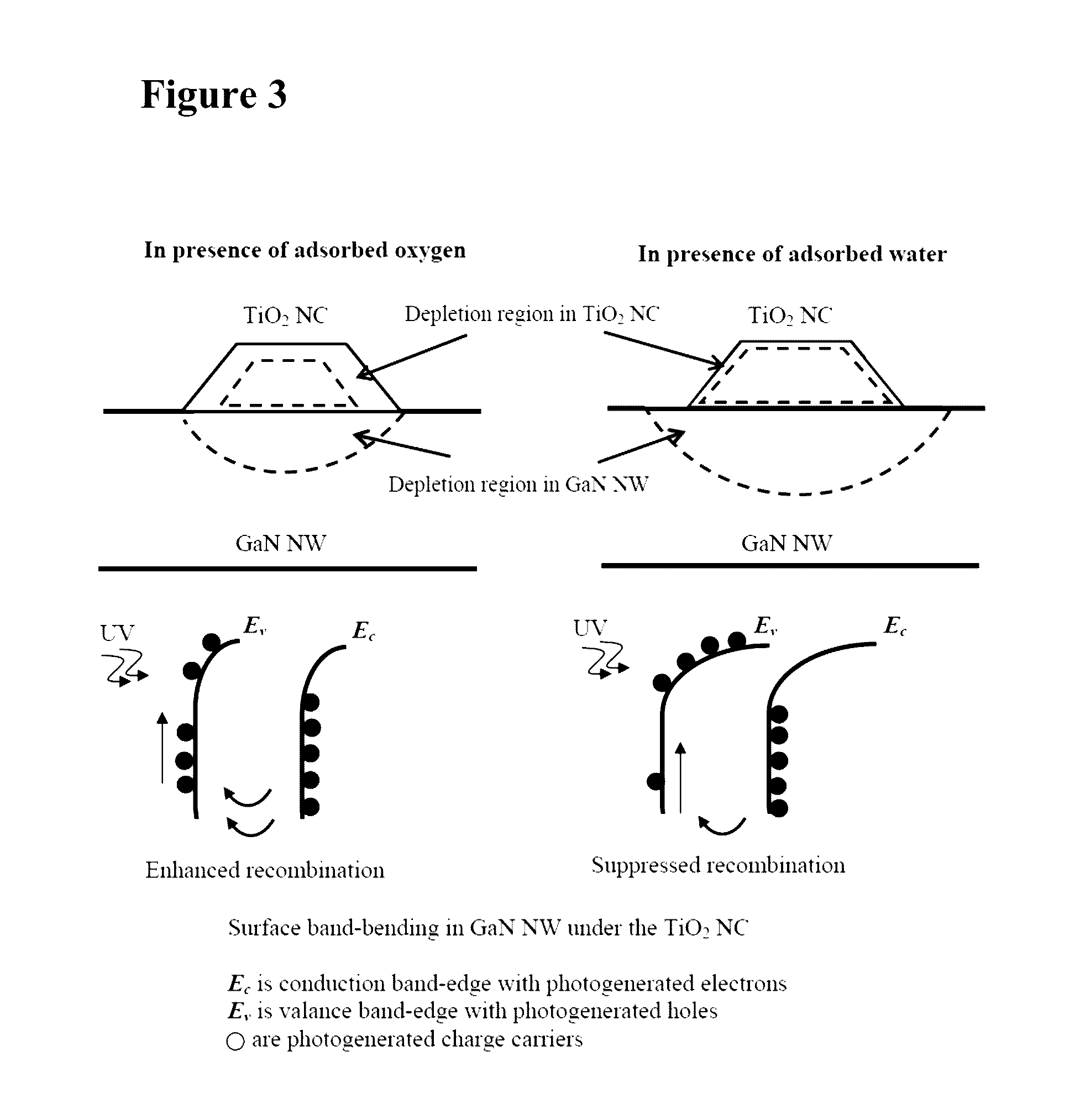Highly Selective Nanostructure Sensors and Methods of Detecting Target Analytes
a nanostructure sensor and target analyte technology, applied in the field of sensing devices, can solve the problems of fundamental challenges and deficiencies in such prior attempts, severely limit the usability of such conventional sensors, and pose long-term reliability problems, and achieve the effect of increasing conductivity
- Summary
- Abstract
- Description
- Claims
- Application Information
AI Technical Summary
Benefits of technology
Problems solved by technology
Method used
Image
Examples
example 1
[0187]Nanowire-nanocluster hybrid chemical sensors were realized by functionalizing gallium nitride (GaN) nanowires (NWs) with titanium dioxide (TiO2) nanoclusters for selectively sensing benzene and other related aromatic compounds.
Materials and Methods
[0188]C-axis, n-type, Si-doped GaN grown by catalyst-free molecular beam epitaxy on Si (111) substrates were utilized. For details of NW growth, see Bertness K A et al. (2008) “Mechanism for spontaneous growth of GaN nanowires with molecular beam epitaxy,” J. Crystal Growth 310(13):3154-3158). An exemplary process of sensor fabrication is shown in FIG. 19. Post-growth device fabrication was done by dielectrophoretically aligning the nanowires on 9 mm×9 mm sapphire substrates (see Motayed A et al. (2006) “Realization of reliable GaN nanowire transistors utilizing dielectrophoretic alignment technique,” J. Appl. Phy. 100:114310). The device substrates had 12 nm thick Ti alignment electrodes of semi-circular geometry with gaps between t...
example 2
[0205]The sensing behavior of three NWNC based hybrid sensors was compared: 1) GaN NW coated with TiO2 NCs (hereafter referred to as GaN / TiO2 NWNC hybrids); 2) GaN NW coated with TiO2 and Pt multicomponent NCs (i.e., GaN / (TiO2—Pt) NWNC hybrids); and 3) GaN NW coated with Pt NCs (i.e., GaN / Pt NWNC hybrids). It was found that sensors with TiO2—Pt multicomponent NCs on GaN NW were only sensitive to methanol, ethanol, and hydrogen. Higher carbon-containing alcohols (such as n-propanol, iso-propanol, n-butanol) did not produce any sensor response. These sensors had the highest sensitivity towards hydrogen. Prior to the Pt deposition, the GaN / TiO2 NWNC hybrids did not exhibit any response to alcohols, however they detected benzene and related aromatic compounds such as toluene, ethylbenzene, xylene, and chlorobenzene mixed with air. The GaN / Pt hybrids only showed sensitivity to hydrogen and not to methanol or ethanol. The sensitivity of GaN / Pt hybrids towards hydrogen was lower compared t...
example 3
[0228]Alcohol sensors using gallium nitride (GaN) nanowires (NWs) functionalized with zinc oxide (ZnO) nanoparticles are demonstrated. These sensors operate at room temperature, are fully recoverable, and demonstrate a response and recovery time on the order of 100 seconds. The sensing is assisted by UV light within the 215-400-nm band and with the intensity of 375 nW / cm2 measured at 365 nm. The ability to functionalize an inactive NW surface, with analyte-specific active metal-oxide nanoparticles, makes this sensor suitable for fabricating multianalyte sensor arrays.
[0229]Methods and Materials
[0230]Si-doped c-axis n-type GaN NWs were grown using catalyst-free molecular beam epitaxy on Si (III) substrate as described in Bertness K A et al. (2008), supra, J. Cryst. Growth 310(13):3154-3158. The NW diameter and length were in the ranges of 250-350 nm and 21-23 μm, respectively. The GaN NWs were detached from the substrate by sonication in isopropanol and dielectrophoretically aligned ...
PUM
 Login to View More
Login to View More Abstract
Description
Claims
Application Information
 Login to View More
Login to View More - R&D
- Intellectual Property
- Life Sciences
- Materials
- Tech Scout
- Unparalleled Data Quality
- Higher Quality Content
- 60% Fewer Hallucinations
Browse by: Latest US Patents, China's latest patents, Technical Efficacy Thesaurus, Application Domain, Technology Topic, Popular Technical Reports.
© 2025 PatSnap. All rights reserved.Legal|Privacy policy|Modern Slavery Act Transparency Statement|Sitemap|About US| Contact US: help@patsnap.com



